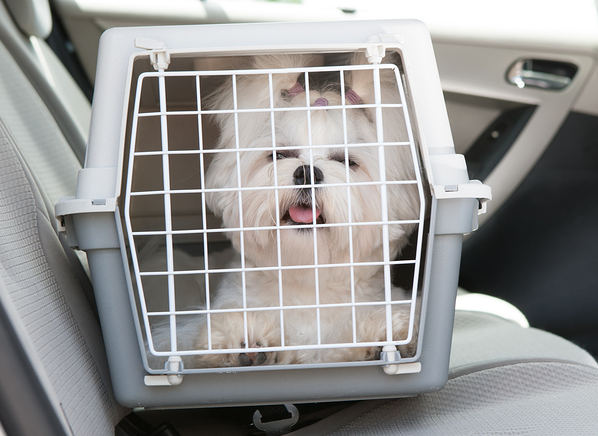The car salesman would not stop talking about cupholders. “This model features seven cupholders! That’s one cupholder for each person! More cupholders than our leading competitor!” he exclaimed.
I sighed, a little impatiently. I needed a van for a specific purpose, and it wasn’t drinking. “I don’t care about cupholders,” I explained. “Just please hold the end of this measuring tape. I need to see if my dog crates will fit.” At that I scrambled into the back of the van and started taking measurements. The salesman, confused into silence, dutifully held the measuring tape.
I bought a minivan for my dogs. At the time I had two Labradors and a Papillon. Each traveled securely in a crate, and I needed to ensure there was enough room in the vehicle for their crates, supplies, and my luggage. The minivan was perfect.
There are several ways to transport your dogs in a car, but they should always be secured. Ever have someone cut you off in traffic so you need to slam on the brakes? Ever have a slippery moment on a slick road or sharp turn? If you’re wearing a seatbelt, you’re not going to be tossed around the car and there’s less chance of getting hurt. A dog loose in the car would not be so lucky.
Options include seatbelt harnesses and crates. For small dogs, you can also find a variety of car seats. In each category, you can find products that have been crash-tested. For a car trip, a sturdy crate is best. If you’re traveling with a small dog about town, a travel carrier with an over-the-shoulder strap or a backpack-style carrier should work well.
Before you hit the road, you first need to get your dog used to the carrier. Most dogs find seatbelt harnesses and car seats easy to tolerate. The biggest issue dogs seem to have with them is the restraint, especially if they are used to bouncing all over the car as they please. Get them used to staying put with a food-stuffed toy, and give lots of praise. If you use a car seat, make sure the attachment allows your dog to lie down comfortably, but doesn’t permit him to jump out.
Carriers and crates will require more training. If your dog is already confinement-trained, getting him used to a different crate will be much easier. If not, you’ll need to start from scratch.
Leave the carrier open in your home. Feed your dog all his meals in the carrier, and randomly throughout the day, toss treats in there for him to find. Gradually work up to closing the door or zipping it shut, then work up to longer and longer times in the carrier.
If you’re transporting a small dog from the house to the car while he’s inside his carrier, hold the carrier as if it contains a precious package—which it does! Use both arms to hold it close to your body instead of letting it swing at your side. (link to article on car travel)
Once your dog learns that the carrier means he gets to go on your travel adventures, he’ll look forward to buckling up safely.
This article was reviewed/edited by board-certified veterinary behaviorist Dr. Kenneth Martin and/or veterinary technician specialist in behavior Debbie Martin, LVT.
Teoti Anderson, CPDT-KA, KPA-CTP, is the vice president of A Dog’s Best Friend, located in Ft. Lauderdale, Florida. A professional dog trainer for more than 23 years, she is the author of The Dog Behavior Problem Solver, Dog Fancy Ultimate Guide to Dog Training, Animal Planet Dogs 101 Dog Training, Puppy Care and Training, The Super Simple Guide to Housetraining, Quick & Easy Crate Training, and Your Outta Control Puppy. A popular conference speaker, she has given presentations to pet owners, humane organizations, and fellow trainers across the United States and internationally.








